Recent Water Damage Posts
My house is flooded, help!
1/17/2024 (Permalink)
Team SERVPRO Deals with Flooding on a Regular Basis
Most homeowners either know somebody who has experienced flooding in their property or they have encountered it themselves. It can be stressful, frustrating, and very messy. It can also end up costing a lot if you do not arrange for repairs right away.
The thing to remember about flood damage in homes is that it can come from all kinds of different places. The easiest way to prevent it is to keep up with routine maintenance. Keeping gutters clean, inspecting pipework regularly, and investing in plumbing services can make sure that your home stays protected.
Keep reading to learn more about flood damage and what happens when SERVPRO is brought in to deal with the aftermath.
What Happens When a House Floods?
Well, the answer is different in all situations. It depends primarily on the severity of the damage and how much water has intruded into the property. Usually, the first item to be compromised is the flooring. Carpets absorb liquid until they are saturated, and any backings or adhesives begin to come loose.
Drywall bows and warps, while wood is prone to swelling because it is more porous than other materials. If not dried and cleaned quickly, it starts to rot. Our technicians perform a visual inspection as soon as they arrive onsite, in order to identify the most vulnerable items and single them out for priority treatment.
Is It Safe When the Standing Water Is Gone?
Extraction of the standing water is only part of the process. Without thorough drying, the materials in your home are not safe from further damage. After 48 hours, mold becomes a risk, and organic substances degrade quickly.
After removal, SERVPRO implements a carefully controlled system of dehumidification and humidity monitoring. Fans, air movers, and powerful dehumidifiers are used in combination to create optimal drying conditions. It prevents the air from filling up with moisture and causing secondary water damage to furniture and other possessions.
How Long Does the Drying Process Take?
Once again, it is different for every home. The two biggest factors are the size of the affected area and the amount of water that has caused the problem. The balance of porous to non-porous materials has an impact on how long it takes to complete the drying process.
The more porous items that become saturated with liquid, the longer it will take to draw the water out. Usually, an average-sized home gets remediated in around 2-4 days, but there are no certainties when it comes to internal flooding. The goal is to complete repairs as quickly as possible, but without compromising on quality.
SERVPRO of Statesboro high-quality restoration is a guarantee. We have access to sophisticated drying equipment, and our technicians are very skilled. Call us 24/7 at (912) 764-9542.
My Leak is Gone, But Now What?
8/26/2021 (Permalink)
Leaky pipes are like termites. They may leave telltale signs, but you often don’t notice them until the damage has been done.
You should occasionally check your home or business for leaking pipes. Insurance companies often do not cover the damage they cause, which is why it’s so important to identify them early.
If your leak is hard to access, you’ll probably have to call in expert help to fix it. But if you can find it, you may be able to repair it by looking up online tutorials.
Become a Leak Detective
Is there a leak? Look for tell-tale signs, such as stains on your ceiling, damaged or loose flooring, or grout and caulking that are coming away. Also, check for loose sink hands or faucets. See if your toilet can be moved, even a little. Plus, check for mold.
Where is That Leak Coming From?
Where exactly is the leak? Grab your flashlight and find out. Check under countertops and sinks. Open the panel behind your tub. For small leaks, fill a sink or tub. Let water drain and check visible pipe joints for dampness. Use a dry tissue or handkerchief to detect small amounts of moisture at joints.
Do You Need a Plumber?
If you can easily get to a leaky pipe, you can likely repair it yourself. But if you have to call a plumber, don’t worry—a small investment now can save you a lot down in the future.
Success! My Leak Is Gone. But My Baseboard Is Moldy…
Have you already experienced damage from a leaky pipe? Call SERVPRO®. We’ve been cleaning up water damage since 1967!
We’ll pick up the phone any time, day or night. As a national company with local ownership, we deliver a powerful combination of national expertise and neighborly customer service.
Have Your Cabinets Been Damaged By Water? SERVPRO Can Help You!
8/26/2021 (Permalink)
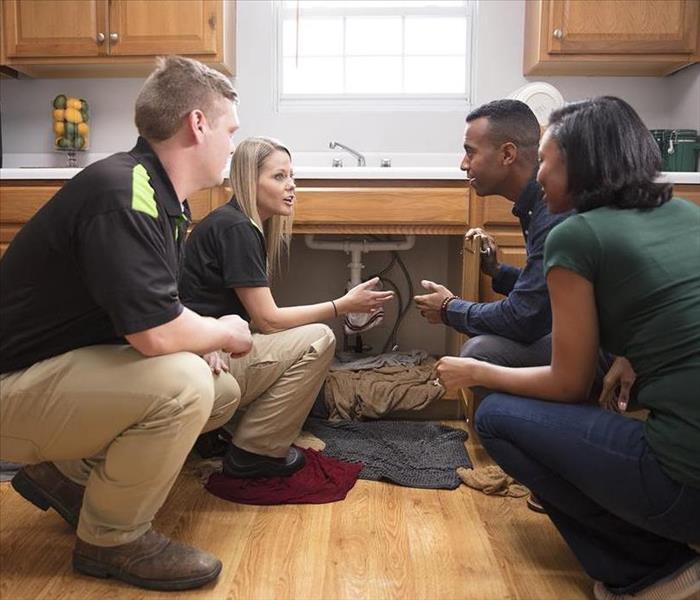 SERVPRO of Statesboro can help you with wet cabinets.
SERVPRO of Statesboro can help you with wet cabinets.
Kitchen Or Bathroom Cabinets Damaged by Water?
Water damage wreaks havoc in homes. All it takes is for a single pipe to burst or one appliance to develop a fault, and a small leak can soon become something much bigger. Coastal Georgia is also prone to flooding at times which means that there is a risk of water affecting your house.
After water damage to your Statesboro area home, you need to get everything dry as quickly as possible. A damp home is unpleasant to be in, and there is more of a risk of long-term damage if you do not take swift action. Damp areas are a breeding ground for secondary issues such as mold spores and mildew.
One of the leading causes of interest for homeowners after a leak or flood of any kind is how to dry out hard-to-reach places such as behind cabinets. Floors and walls around cabinets are not easily accessible, and the extra layers of material there present a significant challenge. SERVPRO recommends contacting our experts for a full assessment of the situation as soon as possible.
Many factors affect drying around and behind cabinetry. These include the types of wood, the paint used, the position, and if the cabinet has its own back or backs onto the wall. Because the backs of cabinets are hard to dry, our IICRC certified technicians are trained to carefully drill holes in either the cabinet or the wall to allow for better air circulation.
Our professional teams also remove molding underneath cabinets and drills holes in the base as necessary to ventilate the floor beneath the cabinet. In many cases, the molding can be put back after and may not need to be replaced by new molding.
Drying under and behind cabinets is not just about creating better ventilation through drilling holes or removing molding. We also use dehumidifiers and air movers to dry the area. Our certified professionals come equipped with powerful vent systems that force dry air under cabinets to speed the drying process.
SERVPRO monitors cabinets carefully every step of the way to ensure that the drying process is as efficient and speedy as possible. We handle your furniture with care, and when drying is complete, we patch any holes and put the molding back - "Like it never even happened."
If you are worried about your cabinets after water damage, give SERVPRO of Statesboro a call at (912) 764-9542.
Water Damage Control
8/21/2021 (Permalink)
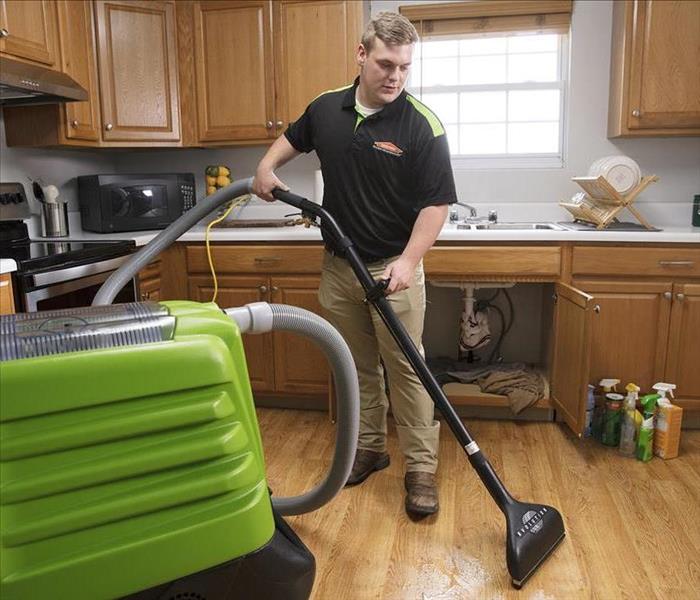 If you've experienced a water loss emergency SERVPRO of Statesboro has a team ready to help around the clock.
If you've experienced a water loss emergency SERVPRO of Statesboro has a team ready to help around the clock.
When homeowners find themselves faced with water damage from a sewage backup or bursting pipes, they often want to know how long the restoration efforts will take. The answer depends on the extent of the damage, the type of water to invade the home and materials used throughout the affected area. Our SERVPRO water restoration team may tell homeowners to expect the process to take anywhere from two to three days, but to not be surprised if it takes as many as seven or longer. Some factors that affect the time it takes to dry out a home include:
• The type of water to flood the home
• The size of the area affected
• The building materials affected
Type of Water
Clean water is easier to clean up than black water, as the former doesn’t require special Hazmat materials or equipment. If your problems stem from bursting pipes, the solution may be as simple as fixing the pipes and drying out the area. If you do so within 24 to 48 hours, you can reduce the likelihood of mold and bacteria growth as well.
Size of Affected Area
The type of water isn’t the only factor to affect restoration times. The size of area plays a huge part as well. If the size of the affected area is relatively small, less than ten square feet, restoration efforts can take as little as two days, and you may even be able to perform them yourself. However, if your entire ground floor is flooded, it could take several days of professional efforts.
Materials Impacted
If it is just your carpet that is affected, restoration efforts shouldn’t require much of your time at all. However, if your drywall, insulation and/or framing are impacted, you may need to do more than fix a broken pipe. Restoration efforts in the latter instance could take as long as 7 days or more.
Every situation is different, and the water damage caused by bursting pipes could be far more severe than damage from, say, a leaking pipe. Talk to your local SERVPRO water damage restoration team to learn more about what to expect. We are always here to help!
Statesboro Area Residents: We Specialize in Flooded Basement Cleanup and Restoration!
8/17/2021 (Permalink)
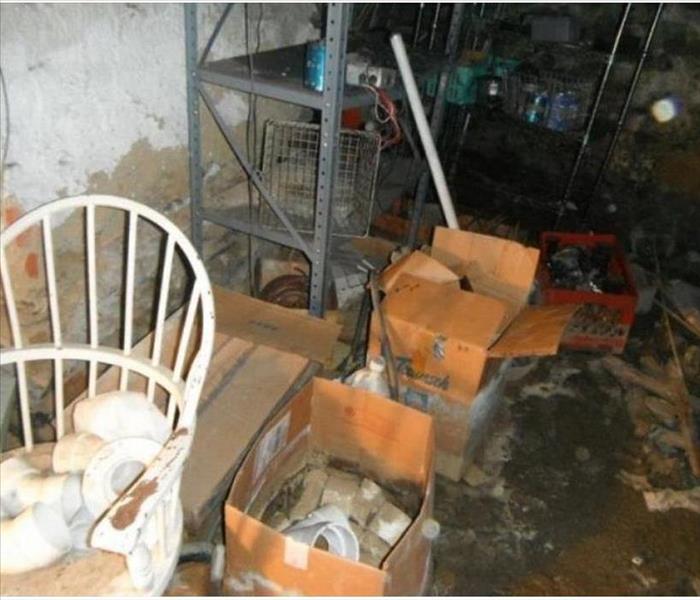 This flooded basement was caused by a recent storm.
This flooded basement was caused by a recent storm.
A basement can flood at any time, although flooding most often occurs during heavy rainfall. Basements are inherently prone to flooding because they are the lowest level of a building and are normally built partly or entirely below ground level. There are a number of reasons why your Statesboro Area basement could flood, including:
- A blocked or failed sewer lateral pipe
- Heavy rain causes surface water to pool around your home
- Storm sewer backup
- Sanitary sewer backup
- Foundation drainage failure
- Water supply-line break or hot-water tank failure
- And many more
Have Questions about Basement Flooding?
Call Today - (912) 764-9542
If flood water is not handled quickly and properly, it can jeopardize your health and safety, and cause severe damage to your home’s structure. Remember, the longer you wait, the worse the problem will get.
The bottom line: a flooded basement can jeopardize your health, safety, and your home’s integrity. It’s worth making a call to SERVPRO of Statesboro and let our trained, professional crews handle the situation safely and correctly. We have earned the trust of hundreds of homeowners, business owners, and property professionals.
We are Flooded Basement Specialists:
- We are Available 24 hours/7 days per week
- We’re a Preferred Vendor to many National Insurance Companies
- We Bill The Insurance Directly – One Less Thing For You To Worry About
- Our Technicians are Highly-Trained in Water Restoration Techniques
- We use s500 IICRC Restoration Standards
- Advanced Inspection and Extraction Equipment
Basement Flooded? Call Us Today – We’re Ready To Help (912) 764-9542
SERVPRO of Statesboro 24 Hour Emergency Water Damage Service
8/6/2021 (Permalink)
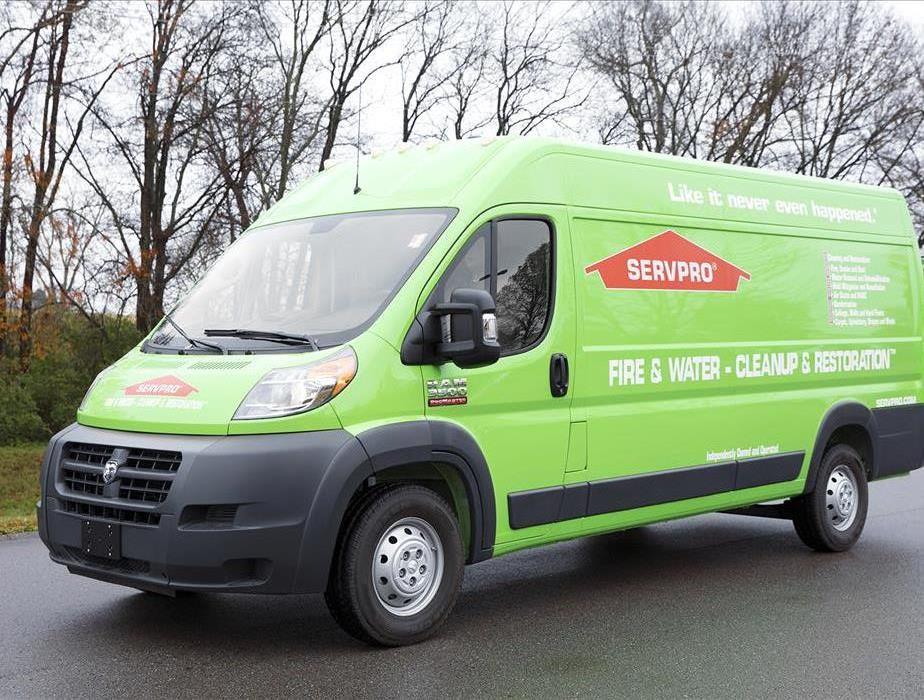 SERVPRO of Statesboro provides 24 hour fire and water damage restoration service in Bulloch, Emanuel, Screven, Jenkins and Candler counties.
SERVPRO of Statesboro provides 24 hour fire and water damage restoration service in Bulloch, Emanuel, Screven, Jenkins and Candler counties.
SERVPRO of Statesboro is available 24 hours a day for water emergencies, large or small. When you are dealing with water damage, immediate action is crucial. A delay of just a few hours can greatly increase the severity of the water damage.
We Answer the Phone Ready to Help
Call Today - 912-764-9542
We understand that when you call us, you may be feeling confused, stressed, and vulnerable. You need an expert to guide you through this crisis. SERVPRO of Statesboro has the specific water damage training and experience to help you through this tough time. We specialize in water damage restoration—in fact, it's the cornerstone of our business.
What to Expect
When you call, we will ask several questions regarding your water damage emergency. These questions will help us determine what equipment and resources to bring, including how many trained SERVPRO Professionals may be needed.
Our SERVPRO Representative will ask several questions:
- Your name and contact information
- Your insurance information (if applicable)
- The street address of the water-damaged home or business
- When did the flooding or water damage occur?
- What caused the water damage (if known)?
- Is there electricity available (on-site)?
About SERVPRO of Statesboro
SERVPRO of Statesboro specializes in the cleanup and restoration of residential and commercial property after a fire, smoke or water damage event. Our staff is highly trained in property damage restoration. From initial and ongoing training at SERVPRO’s corporate training facility to regular IICRC-industry certification, rest assured our staff is equipped with the knowledge to restore your property.
Faster to your Statesboro Area Water Damage Event
8/6/2021 (Permalink)
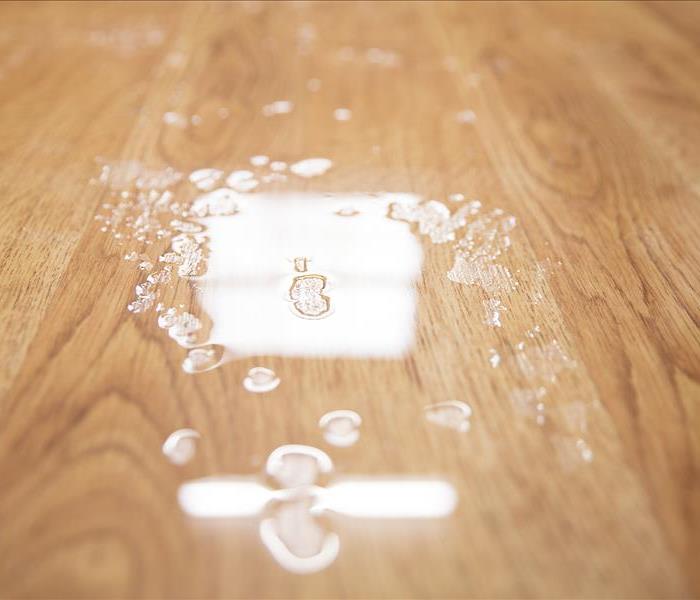 SERVPRO of Statesboro provides 24 hour fire and water damage restoration service in the Statesboro Area
SERVPRO of Statesboro provides 24 hour fire and water damage restoration service in the Statesboro Area
Flooding and water emergencies don’t wait for regular business hours and neither do we. SERVPRO of Statesboro provides emergency cleaning and restoration services 24 hours a day, 7 days a week—including all holidays.
Faster To Any Size Disaster
Flooding and water damage is very invasive. Water quickly spreads throughout your home and gets absorbed into floors, walls, furniture, and more. SERVPRO of Statesboro arrives quickly and starts the water extraction process almost immediately. This immediate response helps to minimize the damage and the cleaning and restoration costs.
Need Emergency Service? Call Us 24/7 – 912-764-9542
Water Damage Timeline
Within Minutes
- Water quickly spreads throughout your property, saturating everything in its path.
- Water is absorbed into walls, floors, upholstery, and belongings.
- Furniture finishes may bleed, causing permanent staining on carpets.
- Photographs, books, and other paper goods start to swell and warp.
Hours 1 - 24:
- Drywall begins to swell and break down.
- Metal surfaces begin to tarnish.
- Furniture begins to swell and crack.
- Dyes and inks from cloth and paper goods spread and stain.
- A musty odor appears.
48 Hours to 1 Week:
- Mold and mildew may grow and spread.
- Doors, windows, and studs swell and warp.
- Metal begins to rust and corrode.
- Furniture warps and shows signs of mold.
- Paint begins to blister.
- Wood flooring swells and warps.
- Serious biohazard contamination is possible.
More Than 1 Week:
- Restoration time and cost increase dramatically; replacing contaminated materials and structural rebuilding may be extensive.
- Structural safety, mold growth, and biohazard contaminants pose serious risks to occupants.
About SERVPRO of Statesboro
SERVPRO of Statesboro specializes in the cleanup and restoration of residential and commercial property after a fire, smoke or water damage event. Our staff is highly trained in property damage restoration. From initial and ongoing training at SERVPRO’s corporate training facility to regular IICRC-industry certification, rest assured our staff is equipped with the knowledge to restore your property.
Foundation problems due to water
4/16/2020 (Permalink)
Do you think you have water damaging your foundation? Lucky for us you are a hands-on homeowner, who fixes and repairs things as needed. The problem is that water damage to foundations is not an easy water damaging problem to identify.
The key to minimizing the damage is to catch it fast and address the issue. But how? Below is a list of the some of the common symptoms of water damage within a house foundation.
A. Overly Damp Soil
If you have an idea that there could be an issue with moisture, take a look at the soil around the foundations of the property. If it is unusually wet without any recent rain, there is a good chance that groundwater is seeping into the foundation.
B. Water in the Crawlspace
Standing water and moisture building up within a crawlspace is a pretty good sign that something is wrong with the foundation, circulation of air, lack of adequate insulation, or a broken pipe. If it is too damp in this area, the quality of the air in your house can decrease, and it may give off a musty odor.
C. Mal-functioning doorframes or windows
This might sound like a surprising sign, but if your doorframes used to open and close correctly, but have recently started to stick, the problem could be moisture related. It may be a sign that the doorframes have begun to warp, from excessive water absorption.
If you notice one or all three of the issues, you may have a problem on your hands. SERVPRO of Statesboro is here to help!
Water Damage Control
4/15/2020 (Permalink)
When homeowners find themselves faced with water damage from a sewage backup or bursting pipes, they often want to know how long the restoration efforts will take. The answer depends on the extent of the damage, the type of water to invade the home and materials used throughout the affected area. Our SERVPRO water restoration team may tell homeowners to expect the process to take anywhere from two to three days, but to not be surprised if it takes as many as seven or longer. Some factors that affect the time it takes to dry out a home include:
• The type of water to flood the home
• The size of the area affected
• The building materials affected
Type of Water
Clean water is easier to clean up than black water, as the former doesn’t require special Hazmat materials or equipment. If your problems stem from bursting pipes, the solution may be as simple as fixing the pipes and drying out the area. If you do so within 24 to 48 hours, you can reduce the likelihood of mold and bacteria growth as well.
Size of Affected Area
The type of water isn’t the only factor to affect restoration times. The size of area plays a huge part as well. If the size of the affected area is relatively small, less than ten square feet, restoration efforts can take as little as two days, and you may even be able to perform them yourself. However, if your entire ground floor is flooded, it could take several days of professional efforts.
Materials Impacted
If it is just your carpet that is affected, restoration efforts shouldn’t require much of your time at all. However, if your drywall, insulation and/or framing are impacted, you may need to do more than fix a broken pipe. Restoration efforts in the latter instance could take as long as 7 days or more.
Every situation is different, and the water damage caused by bursting pipes could be far more severe than damage from, say, a leaking pipe. Talk to your local SERVPRO water damage restoration team to learn more about what to expect. We are always here to help!
Water Damage Requires Professional Clean Up Now to Prevent Problems Later
4/15/2020 (Permalink)
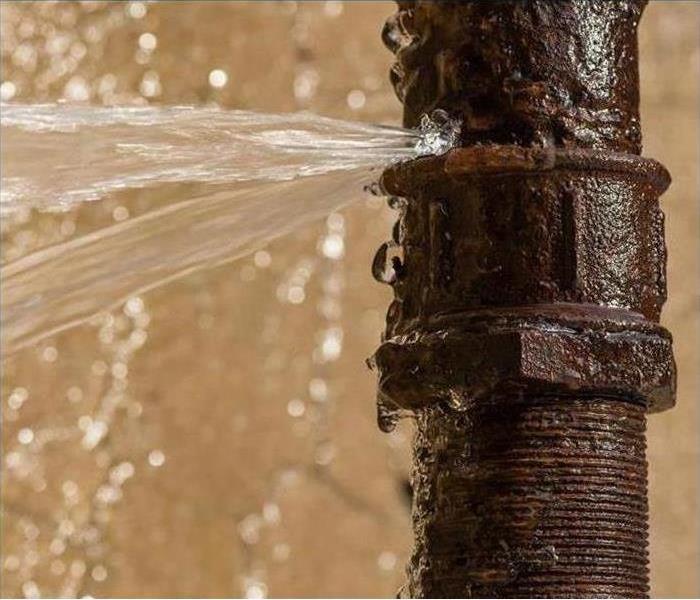 Water damage that results from a broken water line, can cause severe damage throughout the home.
Water damage that results from a broken water line, can cause severe damage throughout the home.
Many people clean their homes prior to leaving for vacation. They also make sure that all the lights are off, and then also check that all windows and doors are locked securely. Many otherwise careful people fail to shut off the water line at the outside of their home during their pre-vacation preparations. Many times, nothing comes of this, but when it does, the water damage can be substantial.
Water damage that results from a broken water line, no matter where the break or leak is located, can cause damage throughout your home. This damage may not only spread across the floor or down the inside of a wall space but from one floor to lower levels, increasing the amount of damage your home experiences.
Vacationing is Only Temporary and So Should Any Water Damage, if You Call for Professional Assistance
Upon returning from vacation, homeowners whose home has been water damaged while they've been away are in for a not-so-pleasant surprise. Shutting off the water should be the first thing done if it can be safely accomplished. Standing water can pose an electrical hazard if electrical outlets or wiring are immersed in the water. If you are not sure about your safety, you should have professionals complete the shut-down the electricity prior to shutting off the water. Everyone should remain clear of the water to be safe.
After the flow of water has been stopped, mop up the existing water using absorbent towels or mops and empty buckets. Dump these outside to keep drains inside your home from becoming clogged by any debris that may be in the water. Because water can infiltrate porous materials like drywall throughout your home, it is tough to remove completely. The structurally water damaged area must have the standing water extracted first. If this is not done properly, warping and deterioration of walls and other structures in your home can quickly occur. Then the absorbed moisture and humidity in the interior environment must be mitigated to acceptable levels. If not, this can lead to not only dangerous structural problems but also the growth of mold and mildew. These can cause health effects in your family members over time.
What We can do For You
Our professionals are trained in not only the removal of water that can cause damage to your home's interior, but we have training in the IICRC approved drying techniques that are designed for maximum efficiency. After cleaning-up and extracted all of the water, we will begin the drying process and take note of any damage that needs to be restored or repaired. Cleaning-up will continue with removing any debris that is left over from repairs, as well.
The professionals at SERVPRO of Statesboro are experienced in responding to water damage emergencies such as ruptured or frozen water lines, and we can respond quickly.
3 things to do while you wait for SERVPRO
4/15/2020 (Permalink)
When you realize there is water in your home, what should you do? First you want to stop the water source. If you are unable to do this, immediately call a plumber. You should also call your insurance company so they can lead you through the steps. We have below 3 of the most important tasks you should do while you wait for SERVPRO of Statesboro to reach your house.
Most importantly your SAFETY. You should make sure you are safe first. That could mean leaving the house completely (even with the water continuing to flow) if it involves an electrical issue. If the water is high enough where you cannot see the floor, it would be a good idea to leave that area. You may not be aware of some dangerous circumstances that are under the water.
Documentation, documentation, documentation. To help your insurance company and to have your peace of mind, document every damage you can. Make sure you can see the time and date of each picture. If you think you are taking too many pictures, odds are you should keep documenting. If you have furniture or appliances that were affected, take pictures of the serial number if you can find it. A good idea is to also walk through each affected (and not affected) areas and video. This will ensure you are catching everything.
Remove any item in harms way. You may be able to start the first step of the cleanup process. If it is safe to do so, remove waterlogged items from the flooded area. The more you can move out, the higher chance the items can be restored.
If you are over your head with a water loss, our IICRC certified technicians will be on site to help with your loss.
April Showers Can Mean Homeowner Headaches
4/12/2020 (Permalink)
April has always been known for the many rain showers that occur. In an effort to ensure that the showers do not damage your home, it is important for you to act before the rain comes! Here are some things you can check to prevent damage to your home!
Check your roof. The shingles can be damaged or just worn down which can create a mess for a homeowner. Make sure you check around the chimney. This can be a place that can easily be damaged during a storm.
Check your foundation. A crack in the foundation can lead to water damaging the home. To prevent water damage, look around your house for puddles, leaks, moisture on the walls, and moisture around the windows.
Check the seals in your home. Around windows and doors, check the caulking which over time can become a major issue. If you are unsure whether it needs it, ask a professional to look at the seal to see whether it needs to be redone or not.
If this April you notice an issue in your home such as water in area where it does not belong, call SERVPRO of Statesboro at (912) 764-9542.
When Every Second Matters!
4/12/2020 (Permalink)
We offer a fast response 7 days a week, 365 days a year, and are available to take your call anytime. Water damage does not wait for Monday at 10:00 AM to happen. We realize that you want to get your life back to normal as soon as possible after a water loss. All our restoration methods meet industry standards, and our technicians are trained to IICRC standards. We have the technology and equipment that help our team ensure your house is back "Like it never even happened." We offer all our customers comprehensive water mitigation services, and we have a long history of working with insurance companies, so your claims are processed as quickly as possible.
No matter what caused your water damage problem, it is imperative that you have a fast response in calling us and that we move quickly and efficiently in making repairs. In just minutes, water can spread to other areas of your home. After a few hours, floors can become unrepairable. After only a few days, water can create severe complications and secondary damage such as microbial growth.
Immediately after the loss, you can do a few things before we get there. The removal of wet items that are not permanently there will help tremendously such as rugs, curtains, and more. If you have furniture in the area where the loss has occurred, move the furniture or place waterproof material under each leg to help avoid more or any damage to the legs of furniture. When you call our office, our technician or crew chief may go over a few more steps to ensure your property can be repaired while we are en route to your house.
At SERVPRO of Statesboro, we understand how crucial it is to move fast after water damage has occurred. Call us as soon as you can after the loss at (912) 764-9542.
Understanding Dehu Specs
1/10/2018 (Permalink)
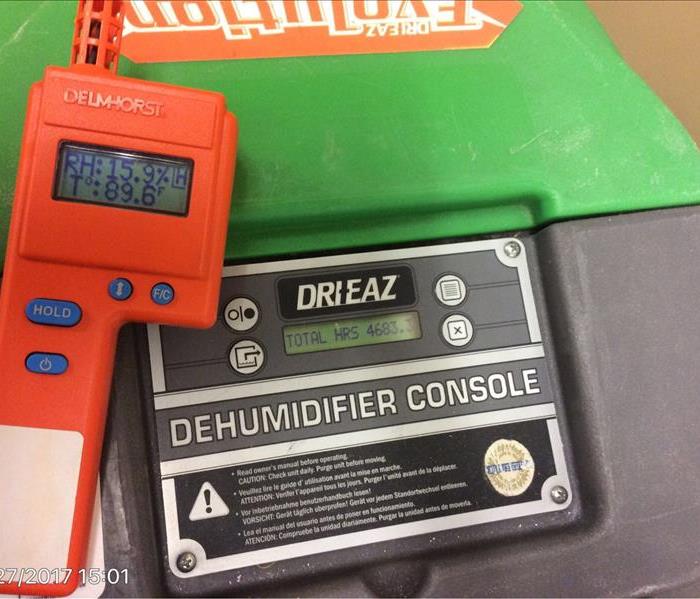
When checking out the specs on a dehumidifier you’ll usually find listed under the section “Water Removal” two numbers. One is noted as AHAM (Association of Home Appliance Manufacturers) and one is “Capacity at Saturation”. But what do these numbers represent and how are they calculated?
AHAM certifies that the PPD (Pints per day) a manu-facturer claims their product will remove is accurate. All dehu’s are tested in a controlled environment where the temperature is 80° F with a relative humidity of 60%. The units are run for 24 hours and the measured amount of extracted water becomes the official AHAM rating.
But even though each dehu is tested the same, the problem is that real world conditions are many times quite different. There have also been questions about whether the ratings that are being applied to “Home” appliances should have any bearing on the type of commercial units that you employ. And that’s where the “saturation” number becomes important.
Saturation can best be described as any extreme condition where the amount of moisture that is in the air is so high that a dehu is forced to run continually over a 24 hour period (100% RH). Situations like this might arise with flooded basements or natural disasters like hurricanes. So the saturation PPD rating will be at the top end of your dehu’s capability.
There exist a sizable number of temperature/humidity combinations that occur naturally or are due to the use of heat drying that causes faster evaporation. These all affect a dehumidifiers performance. Having more than two test conditions listed in the unit’s specs could give you a better idea of its overall performance, but that’s not likely to happen. But having some understanding of its performance capacity will help to ensure you’ve got the right sized unit on the job.
The Need for Air Filtration Device’s on Every Job
1/4/2018 (Permalink)
One of the more fascinating aspects about disaster restoration is that no two jobs are alike. That being said, you will most likely run across at least one of the following conditions 100% of the time:
- Some sort of contamination
- Where you need to dry carpet in place or by floating
- Where structural cavities need drying
- A customer who asks for air filtration
- Customers that are considered to be "at-risk" due to allergies, asthma, etc.
The common denominator of these conditions is that they're all associated with and/or can adversely affect indoor air quality. That’s the reason why you should have air scrubbers (or AFD’s – Air Filtration Devices) running on every job.
When cleaning up sewage, mold or a fire damage, you can’t help but produce considerable amounts of many airborne hazardous materials due to your cleaning efforts. For instance, smoke and fire residues can be poisonous as a fire will destroy plastics, foam, fabrics, carpets, woods, synthetics, and asbestos-containing materials. And any time you unsettle toxins that may be lurking in wall or ceiling enclosures, there’s a good chance that they’ll float into the occupied areas of the structure.
You even need to be concerned about air quality on clean water losses. Due to the need for high-speed air movers to facilitate efficient drying, a myriad of minute particles that are trapped in carpets and furniture are stirred up and can cause adverse health problems to those who are susceptible.
So what are the benefits of having air scrubbers of every job?
- They help to reduce the quantity of possibly harmful air particles, decreasing the chance that occupants or technicians will inhale them.
- You’ll have cleaner equipment with less maintenance.
- Clean equipment also reduces the chance of cross contaminating the next job.
That's why making air scrubbers available on every jobsite makes good business sense.
How to Prevent Frozen Pipes
1/4/2018 (Permalink)
- Keep garage doors closed if there are water supply lines in the garage.
- Open kitchen and bathroom cabinet doors to allow warmer air to circulate around the plumbing. Be sure to move any harmful cleaners and household chemicals up out of the reach of children.
- When the weather is very cold outside, let the cold water drip from the faucet served by exposed pipes. Running water through the pipe - even at a trickle - helps prevent pipes from freezing.
- Keep the thermostat set to the same temperature both during the day and at night. By temporarily suspending the use of lower nighttime temperatures, you may incur a higher heating bill, but you can prevent a much more costly repair job if pipes freeze and burst.
- If you will be going away during cold weather, leave the heat on in your home, set to a temperature no lower than 55° F.
To learn more information on Frozen Pipes and How to Prevent Them, Click on this link, http://www.redcross.org/get-help/how-to-prepare-for-emergencies/types-of-emergencies/winter-storm/frozen-pipes
Provided by the Red Cross.
Flood Facts Quiz
10/5/2016 (Permalink)
1. What is the #1 source of natural disaster losses in the United State?
A. Flood B. Wind C-Fire
2. In a high risk area your home is more likely to be damaged by:
A. Flood B. Fire
3. Most homeowners insurance covers flood damage, true or false?
4. Just a few inches of water from a flood can cause tens of thousands of dollars in damage, true or false?
5. What is it called when winds combine with tides to create a huge wave that push water miles inland?
6. What can cause flooding in mountain areas when the sun is out?
7. From 2005 to 2014 total flood insurance claims averaged more than:
A. $97.6 Million B. $3.5 Billion C. $1.8 Billion
8. What percentage of all flood insurance claims come from outside of mapped high-risk areas?
A. 9% B. 15% C. 20%
9. Storms can cause major flooding in desert states during what season?
Answers:
1. A-Floods
2. B-Floods
3. False
4. True
5. Storm Surge
6. Melting Snow
7. B-$3.5 Billion
8. C-20%
9. Monsoon
The Process of Restoring your Bulloch, Jenkins, Emanuel, Candler and Screven County Properties when there's Water Damage
9/23/2016 (Permalink)
Since every flood and water damage scenario is a little different, each one requires a unique solution tailored for specific conditions. However, the overall water restoration process remains the same.
The steps below detail our restoration process for the typical water-damaged property.
Step 1: 24 Hour Emergency Contact
SERVPRO of Statesboro is available 24 hours a day for water emergencies, large or small. When you are dealing with water damage, immediate action is crucial. Even a delay of a few hours can greatly increase the severity of the damage and increase the chances of microbial growth.
We have the specific water damage training and experience to help you through this tough time. We specialize in water damage restoration – in fact, it’s the cornerstone of our business.
Step 2: Inspection and Damage Assessment
As this stage, our professionals are trying to determine the scope of the damage so that we can develop an appropriate plan of action.
- We’ll identity and stop the water source
- Next, we’ll identify the type of water – the level of contamination of the water will affect the specific restoration processes we use.
- Then, we’ll survey the extent of the water damage and complete the safety inspection
- Lastly, we’ll move furniture and property contents and block items to help prevent rust or furniture stains on wet carpet.
Step 3: Water Removal/Water Extraction
After the inspection and damage assessment step, the water extraction process begins. This step removes the majority of the water. We use powerful pumps and truck-mounted vacuum units to quickly remove hundreds or thousands of gallons of water from your property.
- Move-Out/Pack-Out – SERVPRO of Statesboro can conduct an organized, efficient move-out to protect your belongings from further damage.
- We’ll use Submersible Pumps and Industrial Wet/Dry Vacuums to remove the water.
- Next, we’ll inspect the carpet pad and carpet, and remove if needed.
- Then, we’ll bring in moisture detectors and other meters to measure the extent of the moisture saturation.
Step 4: Drying and Dehumidification
Once the excess water has been removed, the floors and walls may appear dry, but a quick inspection will reveal they are wet to the touch. This retained water can cause the materials to break down, warp or cause mold damage.
- Our professionals will use dehumidification equipment to extract the remaining water.
- We then check the moisture levels to monitor the drying process.
Step 5: Cleaning and Repair
In addition to cleaning your property’s structure, we will clean your furniture, upholstery, clothing and other restorable belongings damaged by the water. Our expertise and “restore” versus “replace” mentality can help you save money while preserving precious keepsakes that can’t be replaced.
- We are trained to identify and eliminate offensive odors, and use antimicrobial and antibacterial treatments to sanitize the area.
- We will also remove and dispose of damaged materials with guidance from you and your insurance adjuster.
Step 6: Restoration
This is the process of restoring your home or business to its pre-water damage condition. Restoration may involve minor repairs, such as replacing drywall and installing new carpet, or may entail major repairs, such as the reconstruction of various areas or rooms in a home or business. SERVPRO of Statesboro can simplify the restoration process by handling both the initial water damage mitigation and rebuilding the affected areas. Having one qualified company for the entire process can save time and keep costs low.
How to Prepare for a Flood
8/8/2016 (Permalink)
How to Prepare for a Flood
You’ll be better prepared to withstand a flood if you have the following items available – packed and ready to go in case you need to evacuate your home
- Water—at least a 3-day supply; one gallon per person per day
- Food—at least a 3-day supply of non-perishable, easy-to-prepare food
- Flashlight [Available on the Red Cross Store]
- Battery-powered or hand-crank radio (NOAA Weather Radio, if possible) [Available on the Red Cross Store]
- Extra batteries
- First Aid kit [Available on the Red Cross Store]
- Medications (7-day supply) and medical items (hearing aids with extra batteries, glasses, contact lenses, syringes, cane)
- Multi-purpose tool
- Sanitation and personal hygiene items
- Copies of personal documents (medication list and pertinent medical information, deed/lease to home, birth certificates, insurance policies)
- Cell phone with chargers
- Family and emergency contact information
- Extra cash
- Emergency blanket
- Map(s) of the area
- Baby supplies (bottles, formula, baby food, diapers)
- Pet supplies (collar, leash, ID, food, carrier, bowl)
- Tools/supplies for securing your home
- Extra set of car keys and house keys
- Extra clothing, hat and sturdy shoes
- Rain gear
- Insect repellent and sunscreen
- Camera for photos of damage
Respond
Responding Appropriately During a Flood
- Listen to area radio and television stations and a NOAA Weather Radio for possible flood warnings and reports of flooding in progress or other critical information from the National Weather Service (NWS)
- Be prepared to evacuate at a moment’s notice.
- When a flood or flash flood warning is issued for your area, head for higher ground and stay there.
- Stay away from floodwaters. If you come upon a flowing stream where water is above your ankles, stop, turn around and go another way. Six inches of swiftly moving water can sweep you off of your feet.
- If you come upon a flooded road while driving, turn around and go another way. If you are caught on a flooded road and waters are rising rapidly around you, get out of the car quickly and move to higher ground. Most cars can be swept away by less than two feet of moving water.
- Keep children out of the water. They are curious and often lack judgment about running water or contaminated water.
- Be especially cautious at night when it is harder to recognize flood danger.
- Because standard homeowner’s insurance doesn’t cover flooding, it’s important to have protection from the floods associated with hurricanes, tropical storms, heavy rains and other conditions that impact the U.S. For more flood safety tips and information on flood insurance, please visit the National Flood Insurance Program Web site at www.FloodSmart.gov.
Recover
Flood Recovery Tips
- Return home only when officials have declared the area safe.
- Before entering your home, look outside for loose power lines, damaged gas lines, foundation cracks or other damage.
- Parts of your home may be collapsed or damaged. Approach entrances carefully. See if porch roofs and overhangs have all their supports.
- Watch out for wild animals, especially poisonous snakes that may have come into your home with the floodwater.
- If you smell natural or propane gas or hear a hissing noise, leave immediately and call the fire department.
- If power lines are down outside your home, do not step in puddles or standing water.
- Keep children and pets away from hazardous sites and floodwater.
- Materials such as cleaning products, paint, batteries, contaminated fuel and damaged fuel containers are hazardous. Check with local authorities for assistance with disposal to avoid risk.
- During cleanup, wear protective clothing, including rubber gloves and rubber boots.
- Make sure your food and water are safe. Discard items that have come in contact with floodwater, including canned goods, water bottles, plastic utensils and baby bottle nipples. When in doubt, throw it out!
- Contact your local or state public health department to see if your water supply might be contaminated. You may need to boil or treat it before use. Do not use water that could be contaminated to wash dishes, brush teeth, prepare food, wash hands, make ice or make baby formula!
Let Your Family Know You're Safe
If your community has experienced a disaster, register on the American Red Cross Safe and Well web site to let your family and friends know about your welfare. You may also call 1-866-GET-INFO to register yourself and your family.



 24/7 Emergency Service
24/7 Emergency Service






